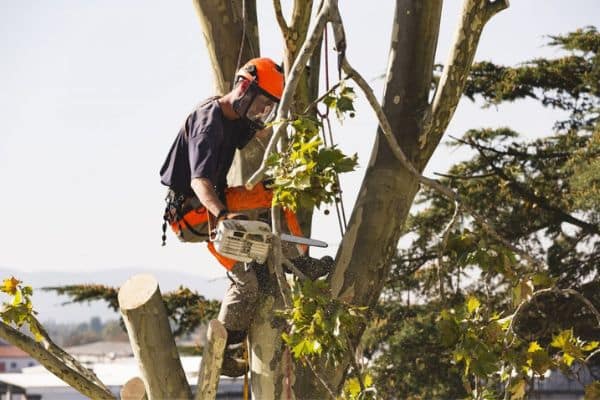
As a homeowner, you know how important it is to maintain your property. From mowing the lawn to cleaning gutters, there’s always something to be done. But have you considered the health and appearance of your trees? Tree pruning is an essential part of tree care that can improve your trees’ health and appearance. In this blog post, we’ll discuss the basics of tree pruning and provide tips to help you keep your trees looking their best.
What is tree pruning?
Tree pruning is the process of removing specific branches or stems to improve the tree’s health, structure, and appearance. This process is essential for a variety of reasons:
To improve the tree’s health: Pruning can help remove diseased or damaged branches, improve air circulation and sunlight exposure, and prevent the spread of disease or insects.
To enhance the tree’s appearance: Pruning can help shape the tree, improve its symmetry, and remove unwanted or unsightly growth.
To promote fruit or flower production: Pruning can help stimulate fruit or flower production by directing the tree’s energy to the desired areas.
To reduce risk: Pruning can help remove potentially hazardous branches, such as those that are dead or weak.
When should you prune your trees?
The best time to prune your trees depends on the type of tree and the reason for pruning. In general, trees should be pruned during their dormant season, which is typically in late fall or winter in Rockville, MD. Pruning during this time can help promote new growth in the spring.
However, some trees, such as maple and birch, should only be pruned in the summer or early fall to avoid excessive bleeding. On the other hand, fruit trees should be pruned in late winter or early spring to promote fruit production.
It’s also important to consider the weather conditions when pruning. Avoid pruning during extreme heat or cold, as this can stress the tree and hinder its ability to recover.
Tools Needed for Tree Pruning
Before you begin pruning your trees, it’s crucial to have the right tools on hand. The most common tools for tree pruning include:
Hand pruners: Used for cutting small branches up to ¾ inch in diameter.
Loppers: Used for cutting branches up to 1 ½ inches in diameter.
Pruning saws: Used for cutting larger branches or limbs.
Pole pruners: Used for reaching high branches without the need for a ladder.
It’s important to use sharp tools to ensure clean cuts that will heal properly. Dull tools can damage the tree and increase the risk of disease or infection.
How to Prune Trees
Know what you’re cutting
Before you begin pruning, identify the branches or parts of the tree that need to be removed. Make sure you’re not removing any branches that are necessary for the tree’s health or appearance.
Make clean cuts
When making cuts, use a clean, sharp tool to ensure a smooth cut that will heal properly. Avoid tearing or ripping the bark, as this can damage the tree and increase the risk of disease or infection.
Avoid topping
Topping or removing the entire top of a tree should be avoided. This can cause stress to the tree and increase the risk of disease or insect infestation. Instead, focus on removing specific branches or parts of the tree as needed.
Don’t prune too much at once
Prune only up to 25% of the tree’s crown at a time to avoid stressing the tree. If you need to remove more than that, spread the pruning over time.
Tree Pruning vs Tree Trimming
Tree pruning and tree trimming are two different tree care methods, although the terms are often used interchangeably.
Tree pruning involves removing dead, diseased, or damaged branches from a tree. This is typically done for safety reasons or to improve the health and appearance of the tree. Tree pruning may also involve removing branches that are growing too close to power lines or other structures or that are obstructing views or walkways. Tree trimming, on the other hand, is the process of shaping a tree for aesthetic purposes. This may involve removing small, healthy branches to improve the overall appearance of the tree, or trimming the branches to create a specific shape or design.
How much does Tree Pruning Cost?
The cost of tree pruning can vary depending on several factors, such as the size of the tree, its location, the extent of pruning required, and the expertise of the tree care professional.
In general, smaller trees with fewer branches to prune will be less expensive than larger trees requiring extensive pruning. Additionally, trees that are located in easy-to-access areas will be less expensive to prune than trees that are in difficult-to-reach areas, such as near power lines or overhanging structures.
Overall, the cost of tree pruning can range from a few hundred dollars to several thousand dollars. It’s always a good idea to get a quote from a qualified tree care professional to ensure that you are getting a fair price for the work you need to be done.
Hire the Right Tree Service Experts
If you’re not comfortable pruning your trees yourself or require extensive pruning, consider hiring a professional tree service such as Yanez Tree Service & Experts in Rockville, MD and nearby areas. We have the knowledge, tools, and experience to prune your trees safely and effectively. Contact us today at (301) 503-9806 to get a free estimate!


No Comments